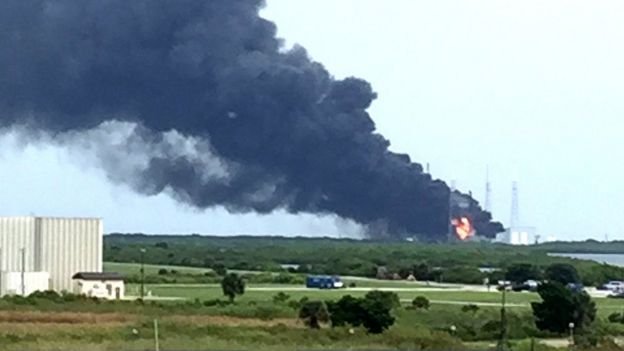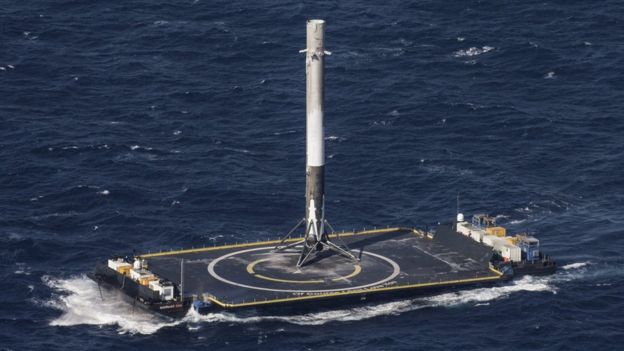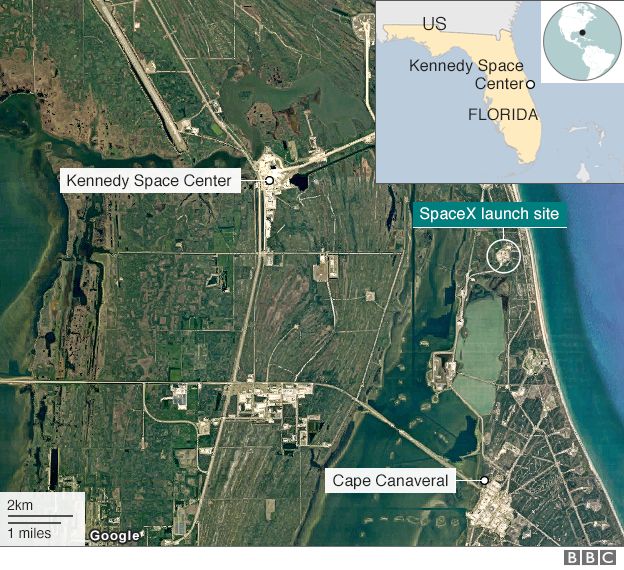A SpaceX rocket exploded on the launch pad at the air force station in Cape Canaveral, Florida, on Thursday morning, as it prepared to carry a communications satellite into space this weekend. The satellite was intended to be used by Facebook, as part of its effort to extend internet access in Africa.
Facebook’s founder and chief executive, Mark Zuckerberg, said in a statement he was “deeply disappointed” by the news.
A little over a year ago, an unmanned SpaceX rocket carrying supplies to the International Space Station exploded shortly after take-off. In a statement issued later on Thursday, US space agency Nasa expressed its confidence in SpaceX as a commercial partner and said the new explosion was “a reminder that spaceflight is an incredible challenge”.
“It’s too early to know whether the incident will affect the schedule for upcoming Nasa-related SpaceX launches to the International Space Station,” the statement said. “If there are SpaceX mission delays, other cargo spacecraft will be able to meet the station’s needs, and supplies and research investigations are at good levels.”
The Nasa statement said the rocket and spacecraft for its next scheduled launch with SpaceX, Osiris-Rex, were “healthy and secure” at a launch site a mile away from the site of the explosion. That mission, to retrieve samples from an asteroid, is due to launch on 8 September.
After Thursday’s blast a huge plume of smoke billowed from the site. Reports claimed the explosion lasted several minutes, destroying the vehicle and shaking buildings for several miles around. The sirens of emergency vehicles could be heard approaching the area.
Initial reports suggested there were no injuries and the private aerospace company’s unmanned Falcon 9 rocket exploded due to a problem with the launch pad, rather than with the rocket itself, during routine engine testing ahead of the planned lift-off on Saturday overnight.

Images quickly emerged on social media showing the site of the incident issuing thick clouds of dark smoke and lit up with flames. Smoke continued to swirl into an overcast sky more than an hour after the reported explosion as witnesses in the area gave accounts of feeling a shock wave.
The SpaceX launch was scheduled to carry an Israeli communications satellite into orbit, with Facebook using some of the satellite’s capacity. It would have been Facebook’s first such launch, as part of Zuckerberg’s attempt to provide internet access to some 14 countries in sub-Saharan Africa that are currently poorly connected.
About 90 minutes after the explosion, with images and reports widespread on television and online but no official word on its cause, SpaceX issued a statementvia Twitter. Both the rocket and the satellite it was carrying had been destroyed, it said.
The statement read: “In preparation for today’s standard pre-launch static fire test, there was an anomaly on the pad resulting in the loss of the vehicle and its payload. Per standard procedure, the pad was clear and there were no injuries.”
Zuckerberg later confirmed in a Facebook post that the satellite had been wrecked. He announced last year that Facebook planned to provide internet access via orbiting satellite to at least 14 sub-Saharan African countries. In his post on Thursday he said he was in Africa, although he did not give a specific location.
His post said: “As I’m here in Africa, I’m deeply disappointed to hear that SpaceX’s launch failure destroyed our satellite that would have provided connectivity to so many entrepreneurs and everyone else across the continent.”
Zuckerberg said the company had alternative ideas and added: “We remain committed to our mission of connecting everyone.”
The SpaceX Falcon 9 rocket was being used to launch the Amos-6 communications satellite for the Israeli company Spacecom. In October 2015, Facebook and the French satellite communications company Eutelsat announced a $95m agreement to lease broadband capacity on the satellite.
According to the website Spacenews.com, at the time, Spacecom, Eutelsat and Facebook reported plans to secure insurance policies to cover risk linked to the satellite project.
SpaceX is the commonly used name for Space Exploration Technologies Corporation, a California-based private aerospace enterprise founded by Elon Musk, chief of Tesla Motors and former PayPal entrepreneur.
The company has succeeded in landing several spent rockets at Cape Canaveral and on a barge in the ocean, although some of the attempts at barge-landings have ended in failure and the explosion on the mission to the International Space Station last year created unwelcome headlines.
Nasa’s statement said: “We remain confident in our commercial partners and firmly stand behind the successful 21st-century launch complex that Nasa, other federal agencies and US commercial companies are building on Florida’s SpaceCoast.”
Quelle: the guardian
---
SpaceX rocket and Israeli satellite destroyed in launch pad explosion
Updated with quotes and 45th Space Wing release.

A SpaceX Falcon 9 rocket exploded in the final minutes of a simulated countdown at Cape Canaveral on Thursday, destroying the booster and an Israeli communications satellite valued at nearly $200 million.
The mishap on Cape Canaveral’s Complex 40 launch pad Thursday will raise questions about the reliability of the Falcon 9 booster, which is slated to haul up cargo to the International Space Station, launch dozens of commercial satellites, and eventually send astronauts into orbit.
The 229-foot-tall (70-meter) launcher exploded at 9:07 a.m. EDT (1307 GMT), a few minutes before a planned ignition of the rocket’s nine Merlin main engines for a brief “static fire” test designed to wring out problems with the launch pad and the vehicle.
Watch a video of the explosion captured a few miles from the launch pad by U.S. Launch Report.
The Falcon 9 was scheduled to blast off early Saturday with the Amos 6 satellite, a nearly 6-ton commercial television and Internet broadcast platform owned by Spacecom Ltd. of Israel.
The mishap destroyed the rocket and the Amos 6 satellite, SpaceX said in a statement. The launch pad was cleared of all personnel for the static fire test, and no injuries were reported.
SpaceX chief executive Elon Musk tweeted that the Falcon 9 rocket anomaly occurred as RP-1 kerosene and liquid oxygen propellants were pumped aboard the launcher. He wrote that the problem apparently “originated around (the) upper stage oxygen tank. Cause still unknown. More soon.”
Images captured in the aftermath of the explosion showed black smoke and flames billowing from the launch pad, and damage to the metal strongback tower that feeds electricity, purge air and propellants into the rocket. Nearby structures, such as the launch pad’s rocket integration hangar and four lightning towers, appeared intact.
“We are continuing to review the data to identify the root cause,” SpaceX said in a statement. “Additional updates will be provided as they become available.”
Saturday’s launch was supposed to be the 29th flight of a Falcon 9 rocket. Another SpaceX launcher disintegrated about two minutes after a liftoff in June 2015 with a Dragon supply ship heading for the space station, but the company had logged nine successful flights in a row since resuming launch operations in December.
A component inside the Falcon 9’s upper stage liquid oxygen tank was the source of last year’s in-flight rocket failure, according to SpaceX. Officials blamed the failure on a sub-standard strut holding one of the tank’s high-pressure helium reservoirs inside the upper stage liquid oxygen tank.
There were no other reports of damage at Cape Canaveral Air Force Station or Kennedy Space Center.
A United Launch Alliance Atlas 5 rocket is set for liftoff Sept. 8 with NASA’s OSIRIS-REx spacecraft on a $1 billion mission to travel to an asteroid and return a sample to Earth. Initial assessments show the robotic science probe and its launcher are healthy and secure inside the Vertical Integration Facility near the Atlas 5 pad about 1.1 miles north of the SpaceX launch facility, NASA said.
“Days like today are difficult for many reasons,” said Brig. Gen. Wayne Monteith, commander of the U.S. Air Force’s 45th Space Wing, which oversees Cape Canaveral Air Force Station. “There was the potential for things to be a lot worse; however, due to our processes and procedures no one was injured as a result of this incident.
“I am proud of our team and how we managed today’s response and our goal moving forward will be to assist and provide support wherever needed,” Monteith said in a statement. “Space is inherently dangerous and because of that, the Air Force is always ready.”
Before Thursday’s incident, SpaceX had around nine launches left to execute before the end of this year, according to statements from the company’s numerous customers about their intentions. Next up after the Amos 6 launch was the first of seven Iridium satellite deployment flights Sept. 19 from Vandenberg Air Force Base, California, with 10 spacecraft for the company’s next-generation voice and data relay network.
In late October, SpaceX planned to fly a recycled Falcon 9 first stage for the first time with the SES 10 communications satellite to provide coverage over Latin America. SpaceX and SES announced the first-of-its-kind reusable launch agreement earlier this week, after recovering six of its last nine rocket boosters with propulsive rocket-assisted landings.
SpaceX’s next space station cargo mission was on track for liftoff in November with several tons of supplies and experiments, including an externally-mounted package of U.S. Air Force research investigations and a multimillion-dollar NASA instrument to study Earth’s ozone layer.
Other missions that were on SpaceX’s manifest later this year included missions for Inmarsat, EchoStar, South Korea’s KTsat, another flight for SES, a tandem launch for Taiwan’s National Space Organization and Seattle-based Spaceflight Industries, and the second batch of 10 Iridium satellites.
The impact of Thursday’s explosion on SpaceX’s upcoming missions was not clear, but with an investigation underway and the company’s main launch pad damaged, some delays are all but certain.
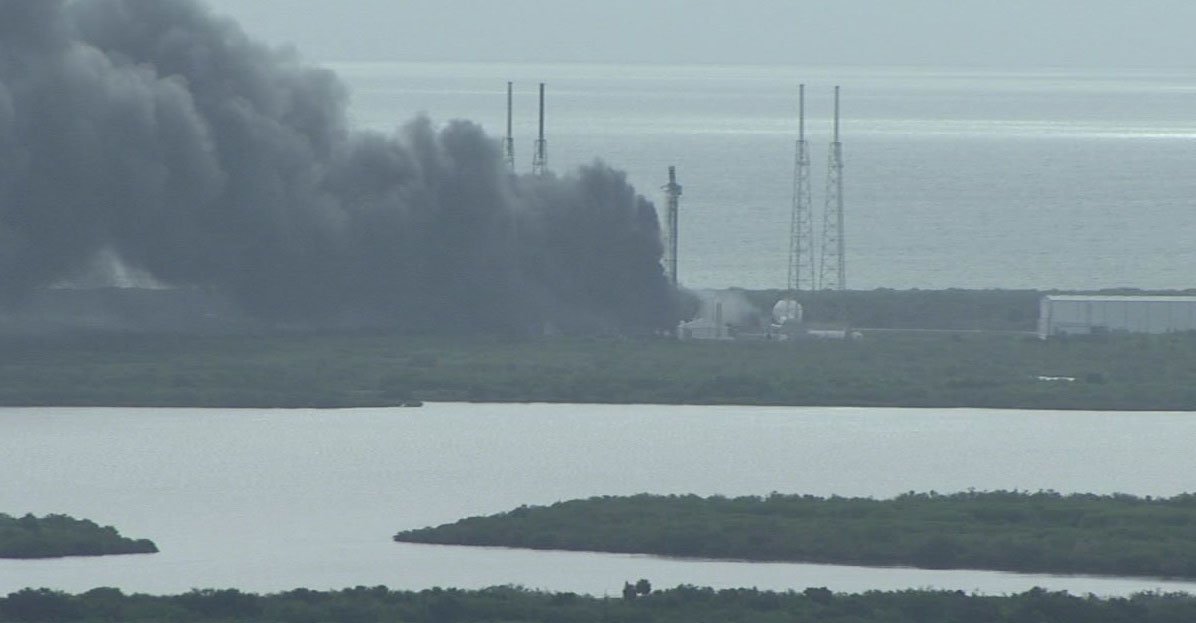
Kirk Shireman, NASA’s International Space Station program manager, spoke with Spaceflight Now Thursday morning shortly after the Falcon 9 rocket and the Amos 6 satellite were destroyed on the launch pad at Cape Canaveral.
The space station program is SpaceX’s biggest customer, with three separate multibillion-dollar contracts to ferry supplies to and from the orbiting research complex, and eventually transport astronauts.
“I have reached out to SpaceX and offered our assistance,” Shireman told Spaceflight Now in a previously scheduled interview at the Johnson Space Center in Houston. “We have people and resources there at KSC and across the country. They are understandably very busy, so that’s all. I just reached out and said we have resources. We’re at your disposal.”
SpaceX has launched nine commercial resupply missions to the space station with its Falcon 9 rocket and Dragon cargo capsule. Eight of those flights reached the outpost, and one failed during the launch in June 2015.
The next cargo mission by SpaceX was slated for liftoff Nov. 11, but that date could be in jeopardy after Thursday’s launch pad mishap in Florida.
“We carry margin on orbit in terms of crew supplies, critical spares and science to allow for these kinds of things,” Shireman said. “It’s not a critical situation for us on orbit. Who knows what, if any, disruption there will be to the supply chain as a result of this.”
Using a fleet of SpaceX Dragon, Orbital ATK Cygnus, and Russian Progress logistics freighters, officials spent the last year-and-a-half restocking the space station with provisions and science gear after three launch failures in 2014 and 2015.
In October 2014, an Orbital ATK Antares launcher crashed moments after blastoff from Virginia, destroying a Cygnus cargo craft heading for the space station. A Russian Progress supply ship spun out of control shortly after reaching orbit atop a Soyuz rocket in April 2015, then a Falcon 9 booster disintegrated in mid-air in June 2015 about two minutes after liftoff with a Dragon cargo carrier.
The trio of mission failures never endangered the space station’s crew — they always have a reserve of food and critical supplies — but it diminished the stockpiles managers send to the complex just in case of such problems.
“We actively track and plan for logistics on-board ISS, and by logistics I mean not only food and water for the crew, but we’re also talking critical spares for equipment that has to work, like oxygen generation, carbon dioxide removal, the toilet, all those things that really have to work,” Shireman said. “We also track logistics for science. We track what our science program is, and we carry reserve science as well.
“In terms of spares on orbit, critical spares for hardware, I would say we’re close” to reconstituting the reserves lost last year, he said. “We’re not quite recovered. In terms of food, water and science, yes. Our No. 1 priority was, of course, we want to keep the crew healthy, but it was really also science. And then it was building back up the spare posture we’d like to have on orbit, and we’re close to that.”
NASA’s other space station cargo provider, Orbital ATK, is in the final stages of preparing an upgraded Antares rocket for its first flight since the October 2014 mishap. Orbital ATK replaced the Russian-made AJ26 engines blamed for that failure with two new RD-181 powerplants, and engineers have spent the last couple of months wrangling with technical issues to ensure the RD-181s are ready.
In the meantime, Orbital ATK ordered two Atlas 5 rockets from ULA for a pair of Cygnus resupply flights in December and March, ensuring the station’s supply chain remained largely intact while the Antares and Falcon 9 launchers were grounded and returning to flight status.
Those two missions were successful, and now attention turns to the resumption of Antares launches from Wallops Island, Virginia.
Shireman said NASA is treating the re-engined Antares booster — dubbed the Antares 230 — like a “brand new rocket” and will avoid placing one-of-a-kind high-priority items aboard the mission, which is currently slated for late September. If SpaceX’s launch schedule slips — as widely expected — the Antares flight needs to go well to ensure NASA has unfettered access to the space station for cargo deliveries.
“Antares 230 is about to fly for the very first time, so I don’t think our supply chain is really back to normal,” Shireman said. “We are looking forward to Antares flying quickly, and at that point we would feel comfortable. We’d feel that our supply chain is where we expected it to be.”
A Japanese HTV cargo mission is scheduled for launch around December to deliver more equipment to the space station, including six new lithium-ion batteries for the research lab’s huge power truss.
A Russian Progress refueling and resupply capsule is due for launch Oct. 20.
“Our supply chain, fortunately, has dissimilar redundancy,” Shireman said. “Today, we have HTV, we have SpaceX, we have Orbital ATK’s Cygnus, we have Russian Energia Progress vehicles, and then we have a little cargo we can fly up on Soyuz, too. All those things allow us to carry cargo.
“When you lose one of those capabilities, even temporarily, yes, it’s an impact,” he said Thursday morning. “What specific impacts there will be is hard to say. If it’s a disruption, we’ll manage it. We’re very good at anticipating what things could happen and positioning ourselves to be tolerant to those things, and then recovering from them.
“We still have Cygnus and HTV coming up. We have Progresses and even Soyuz,” Shireman said. “There are plenty of opportunities for us to carry up cargo to the ISS.”
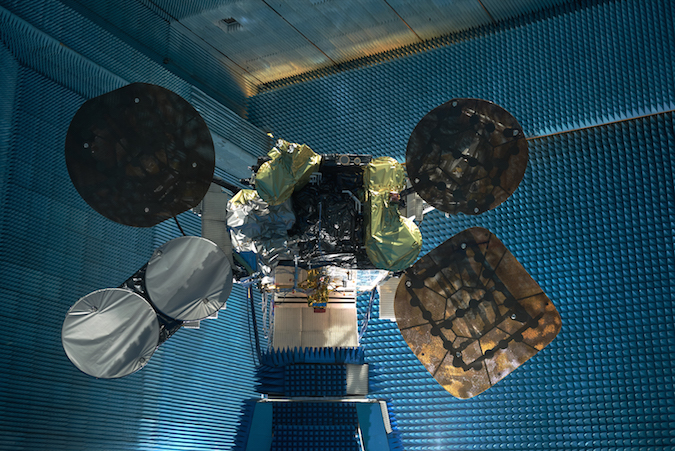
Rocket launches are risky, and failures occur regularly, but catastrophic explosions on the ground like Thursday’s launch pad blast are very rare.
Jonathan McDowell, an astrophysicist at the Harvard-Smithsonian Center for Astrophysics who keeps a respected catalog of space activities, said he believes the last time such a mishap occurred at Cape Canaveral on an orbital-class rocket before liftoff was in 1959, when an Atlas-Able booster exploded during a static fire test.
More recently, a Brazilian VLS satellite launcher exploded on its launch pad in 2003 when one of its solid rocket boosters inadvertently ignited, killing 21 people. That was the last time an orbital-class rocket was lost in a mishap on the launch pad before liftoff.
The Amos 6 satellite fastened on top of the Falcon 9 rocket during Thursday’s doomed test was fully fueled with several tons of toxic hydrazine and nitrogen tetroxide propellants for orbital maneuvers. Built by Israel Aerospace Industries, the satellite was about to set off on a 16-year mission to broadcast direct-to-home television across Europe and the Middle East.
Spacecom signed a $195 million contract with IAI for the Amos 6 satellite in 2012, and the new craft was supposed to replace the aging Amos 2 launched on a Soyuz rocket in 2003.
Opher Doron, general manager of IAI’s space division, said in an interview before Thursday’s mishap that the Amos 6 spacecraft weighed nearly 11,600 pounds — 5,250 kilograms — with a full tank of propellant, making it the largest and heaviest satellite ever produced in Israel.
Eutelsat and Facebook leased a portion of Amos 6’s communications payload to provide broadband Internet access across sub-Saharan Africa, part of an initiative by the social media company to connect the developing world.
“As I’m here in Africa, I’m deeply disappointed to hear that SpaceX’s launch failure destroyed our satellite that would have provided connectivity to so many entrepreneurs and everyone else across the continent,” wrote Mark Zuckerberg, Facebook’s founder and CEO, in a post to his social media site Thursday.
“Fortunately, we have developed other technologies like Aquila that will connect people as well,” Zuckerberg wrote, referring to a solar-powered high-altitude drone developed to beam Internet signals down to Earth. “We remain committed to our mission of connecting everyone, and we will keep working until everyone has the opportunities this satellite would have provided.”
Spacecom has not confirmed whether the spacecraft was fully insured for a total loss before liftoff.
Two industry sources familiar with space insurance arrangements for Falcon 9 launches said standard satellite insurance policies should likely cover risks to the spacecraft during SpaceX’s static fire test.
SpaceX has always conducted a customary “static fire” test before each launch, using it as a rehearsal for the launch team and as a way to verify the rocket and ground systems are ready. In 2014, SpaceX started regularly executing the static fire tests with the rocket’s payload on-board, first with Dragon cargo capsules heading to the space station, then with commercial satellites.
Quelle: SN
-
Update: 3.09.2016
.
Israel’s aerospace industry fears fallout from satellite loss
Space minister convenes urgent talks after explosion destroys the Amos-6, while ISA head warns blast could threaten $285M sale of satellite operator Spacecom
The Amos-6, Israel's largest ever satellite, and the SpaceX Falcon 9 rocket on which it was perched go up in flames after the rocket exploded on the launch pad during a static fire test at a launch facility at Cape Canaveral in Florida on September 1, 2016. (YouTube screen capture)The Amos-6, Israel's largest ever satellite, and the SpaceX Falcon 9 rocket on which it was perched go up in flames after the rocket exploded on the launch pad during a static fire test at a launch facility at Cape Canaveral in Florida on September 1, 2016. (YouTube screen capture)NEWSROOM
The unmanned SpaceX Falcon 9 rocket exploded during a test in Florida on Thursday, destroying the Israeli-built and -owned Amos-6 satellite that Facebook planned to use to beam high-speed internet to sub-Saharan Africa.
Dramatic footage broadcast by ABC News showed the rocket burst into a ball of flame amid what appeared to be a succession of blasts — sending its payload tumbling to the ground as a dense plume of black smoke filled the air.
ISA chairman Yitzchak Ben-Yisrael said the blast’s shock waves could reverberate far beyond Cape Canaveral.
Professor Yitzchak Ben-Yisrael (photo credit: Kobi Gideon/Flash90)
Professor Yitzchak Ben-Yisrael (Kobi Gideon/Flash90)
He said the incident could jeopardize a pending deal for the sale of private Israeli firm and Amos-operator Spacecom to China’s Xinwei group, reportedly worth $285 million and conditional on the satellite successfully entering service.
“This is the second blow, ahead of the Chinese deal,” he said, recalling the blackout of the Amos-5 satellite, which like Amos-6 was owned and operated by Spacecom.
Communication with the Franco-Italian made Amos-5 was lost in November 2015, four years after it was launched from Kazakhstan.
“There is a major question about the launch and I very much hope that Spacecom is strong enough to overcome these things and to order a new satellite,” Ben-Yisrael told Israeli radio.
“If it orders a new satellite, it will take between two and three years to fill the gap.”
Israeli business paper Globes said Thursday that the loss of the Amos-6 could directly impact on Spacecom stock, which tumbled by almost 9% in the wake of the Cape Canaveral explosion. There are, Globes said, concerns that the share price will fall further.
According to the paper, a successful launch of the satellite would have yielded Spacecom $100 million from Facebook and another $164 million from the Israeli government. And while the satellite itself was insured for $330 million, the company had issued bonds of some NIS 1 billion ($265.5 million) to fund the project, and could find itself with a monetary shortfall for “ongoing expenses.”
‘Strategic’ business for Israel
Amos-6 manufacturer Israel Aircraft Industries (IAI) said the satellite was “the largest and most advanced communications satellite ever built in Israel.”
“Obviously, we are disappointed about this incident in the launch vehicle and are ready and willing to assist Spacecom in any manner,” it said. “The communications satellite business is strategic for IAI and the State of Israel.”
The Israel Space Agency, part of the country’s Science, Technology and Space Ministry, said that “support for the space industry in Israel will continue with the aim of continuing at the forefront of technology.”
It said Science, Technology and Space Minister Ofir Akunis would convene industry leaders on Sunday for “an emergency debate and situation report.”
Workers for Israel Aerospace Industries building the Amos-6 satellite, in footage aired September 1, 2016. (screen capture: Channel 2)
Workers for Israel Aerospace Industries building the Amos-6 satellite, in footage aired September 1, 2016. (screen capture: Channel 2)
David Zusiman, former project manager for the Amos-3 and 4 satellite projects and involved with the early stages of the Amos-6, said the explosion was a setback but not necessarily a disaster.
“Amos-6 can be replaced by an identical satellite which it will be possible to order immediately, thanks to the insurance money they will get,” he said in an interview on public radio.
“The insurance is supposed to cover the cost of a complete satellite, including a new launch.”
The Amos-6 has an estimated value of between $200 million and $300 million, according to John Logsdon, former director of the Space Policy Institute at George Washington University.
“The problem is that Amos-6 was supposed to replace Amos-2 which is now quite old and needs replacing,” Zusiman said.
“There are a number of satellites on the international market which could match Amos-2, they are also old but they could still work for a few more years,” he added. “The clients who bought the extra capability of Amos-6 could suffer damage because it sets back their programs by two to three years.”
Channel 2 said Thursday that the destruction of the Amos-6 could adversely impact on Israeli subscribers to the Yes satellite company, which relies on the Amos-2 and 3 satellites to broadcast. The destroyed satellite was supposed to replace the Amos-2, which went into orbit in 2003.
The AMOS 3 satellite (Photo credit: Spacecom via Tsahi Ben-Ami/FLASH 90)
The Amos-3 satellite (Spacecom via Tsahi Ben-Ami/FLASH 90)
Now reliant on just one satellite, at least in the short term, the company could face a breakdown in transmissions if there are any technical difficulties with the Amos-3. In any event, Yes could be forced to reduce the number of channels it offers, but says it will not remove popular channels, Channel 2 reported.
Yes was quick to deny Thursday that it would be impacted by the explosion, writing on Twitter that “Amos-6’s failure to launch will not harm Yes’ broadcasts or viewing experience. We will continue to broadcast as usual and provide our customers with the best television in Israel.”
David Zusiman also cast doubt on any adverse impact for Israel’s space projects, highlighting IAI’s “100 percent” success rate with its launched satellites.
“I don’t know if the image of the Israeli space industry will be harmed,” he said. “From a rational point of view there was a fault with a small part of the system. The rocket is reliable, it works. The IAI satellite has 100 percent success in space, something very rare.”
Quelle: THE TIMES OF ISRAEL




